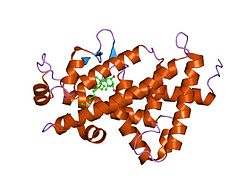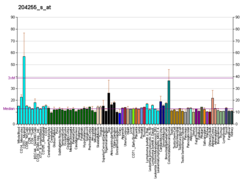Reseptor vitamin D
protein
Reseptor vitamin D (bahasa Inggris: vitamin D receptor, disingkat VDR), reseptor kalsitriol, atau NR1I1 adalah sebuah faktor transkripsi.[4] Kalsitriol (bentuk aktif vitamin D) mengikat pada reseptor ini, yang kemudian membentuk heterodimer dengan reseptor retinoid-X. Kemudian terbentuk ikatan dengan elemen respons hormon pada DNA yang akan berujung pada ekspresi atau transrepresi produk gen tertentu. Reseptor vitamin D tidak hanya mengatur respons transkripsional, tetapi juga turut serta dalam mekanisme post transkripsional yang diarahkan oleh mikroRNA.[5] Pada manusia, reseptor vitamin D disandikan oleh gen VDR.[6]
Interaksi
suntingReseptor kalsitriol terbukti dapat berinteraksi dengan:
Referensi
sunting- ^ a b c GRCm38: Ensembl release 89: ENSMUSG00000022479 - Ensembl, May 2017
- ^ "Human PubMed Reference:". National Center for Biotechnology Information, U.S. National Library of Medicine.
- ^ "Mouse PubMed Reference:". National Center for Biotechnology Information, U.S. National Library of Medicine.
- ^ Moore DD, Kato S, Xie W, Mangelsdorf DJ, Schmidt DR, Xiao R, Kliewer SA (December 2006). "International Union of Pharmacology. LXII. The NR1H and NR1I receptors: constitutive androstane receptor, pregnene X receptor, farnesoid X receptor alpha, farnesoid X receptor beta, liver X receptor alpha, liver X receptor beta, and vitamin D receptor". Pharmacol. Rev. 58 (4): 742–59. doi:10.1124/pr.58.4.6. PMID 17132852.
- ^ Lisse TS, Chun RF, Rieger S, Adams JS, Hewison M (June 2013). "Vitamin D activation of functionally distinct regulatory miRNAs in primary human osteoblasts". J Bone Miner Res. 28 (6): 1478–14788. doi:10.1002/jbmr.1882. PMC 3663893 . PMID 23362149.
- ^ Szpirer J, Szpirer C, Riviere M, Levan G, Marynen P, Cassiman JJ, Wiese R, DeLuca HF (September 1991). "The Sp1 transcription factor gene (SP1) and the 1,25-dihydroxyvitamin D3 receptor gene (VDR) are colocalized on human chromosome arm 12q and rat chromosome 7". Genomics. 11 (1): 168–73. doi:10.1016/0888-7543(91)90114-T. PMID 1662663.
- ^ Guzey M, Takayama S, Reed JC (December 2000). "BAG1L enhances trans-activation function of the vitamin D receptor". J. Biol. Chem. 275 (52): 40749–56. doi:10.1074/jbc.M004977200. PMID 10967105.
- ^ a b c d e Kitagawa H, Fujiki R, Yoshimura K, Mezaki Y, Uematsu Y, Matsui D, Ogawa S, Unno K, Okubo M, Tokita A, Nakagawa T, Ito T, Ishimi Y, Nagasawa H, Matsumoto T, Yanagisawa J, Kato S (June 2003). "The chromatin-remodeling complex WINAC targets a nuclear receptor to promoters and is impaired in Williams syndrome". Cell. 113 (7): 905–17. doi:10.1016/S0092-8674(03)00436-7. PMID 12837248.
- ^ Zhao G, Simpson RU (2010). "Membrane Localization, Caveolin-3 Association and Rapid Actions of Vitamin D Receptor in Cardiac Myocytes". Steroids. 75 (8–9): 555–9. doi:10.1016/j.steroids.2009.12.001. PMC 2885558 . PMID 20015453.
- ^ a b c Ito M, Yuan CX, Malik S, Gu W, Fondell JD, Yamamura S, Fu ZY, Zhang X, Qin J, Roeder RG (March 1999). "Identity between TRAP and SMCC complexes indicates novel pathways for the function of nuclear receptors and diverse mammalian activators". Mol. Cell. 3 (3): 361–70. doi:10.1016/S1097-2765(00)80463-3. PMID 10198638.
- ^ a b Tagami T, Lutz WH, Kumar R, Jameson JL (December 1998). "The interaction of the vitamin D receptor with nuclear receptor corepressors and coactivators". Biochem. Biophys. Res. Commun. 253 (2): 358–63. doi:10.1006/bbrc.1998.9799. PMID 9878542.
- ^ a b c d Puccetti E, Obradovic D, Beissert T, Bianchini A, Washburn B, Chiaradonna F, Boehrer S, Hoelzer D, Ottmann OG, Pelicci PG, Nervi C, Ruthardt M (December 2002). "AML-associated translocation products block vitamin D(3)-induced differentiation by sequestering the vitamin D(3) receptor". Cancer Res. 62 (23): 7050–8. PMID 12460926.
- ^ Herdick M, Steinmeyer A, Carlberg C (June 2000). "Antagonistic action of a 25-carboxylic ester analogue of 1alpha, 25-dihydroxyvitamin D3 is mediated by a lack of ligand-induced vitamin D receptor interaction with coactivators". J. Biol. Chem. 275 (22): 16506–12. doi:10.1074/jbc.M910000199. PMID 10748178.
- ^ a b c Zhang C, Baudino TA, Dowd DR, Tokumaru H, Wang W, MacDonald PN (November 2001). "Ternary complexes and cooperative interplay between NCoA-62/Ski-interacting protein and steroid receptor coactivators in vitamin D receptor-mediated transcription". J. Biol. Chem. 276 (44): 40614–20. doi:10.1074/jbc.M106263200. PMID 11514567.
- ^ He B, Wilson EM (March 2003). "Electrostatic Modulation in Steroid Receptor Recruitment of LXXLL and FXXLF Motifs". Mol. Cell. Biol. 23 (6): 2135–50. doi:10.1128/MCB.23.6.2135-2150.2003. PMC 149467 . PMID 12612084.
- ^ a b Baudino TA, Kraichely DM, Jefcoat SC, Winchester SK, Partridge NC, MacDonald PN (June 1998). "Isolation and characterization of a novel coactivator protein, NCoA-62, involved in vitamin D-mediated transcription". J. Biol. Chem. 273 (26): 16434–41. doi:10.1074/jbc.273.26.16434. PMID 9632709.
- ^ Vidal M, Ramana CV, Dusso AS (April 2002). "Stat1-Vitamin D Receptor Interactions Antagonize 1,25-Dihydroxyvitamin D Transcriptional Activity and Enhance Stat1-Mediated Transcription". Mol. Cell. Biol. 22 (8): 2777–87. doi:10.1128/MCB.22.8.2777-2787.2002. PMC 133712 . PMID 11909970.
- ^ Ward JO, McConnell MJ, Carlile GW, Pandolfi PP, Licht JD, Freedman LP (December 2001). "The acute promyelocytic leukemia-associated protein, promyelocytic leukemia zinc finger, regulates 1,25-dihydroxyvitamin D(3)-induced monocytic differentiation of U937 cells through a physical interaction with vitamin D(3) receptor". Blood. 98 (12): 3290–300. doi:10.1182/blood.V98.12.3290. PMID 11719366.
Bacaan lanjut
sunting- Hosoi T (2002). "[Polymorphisms of vitamin D receptor gene]". Nippon Rinsho. 60 Suppl 3: 106–10. PMID 11979895.
- Uitterlinden AG, Fang Y, Van Meurs JB, Pols HA, Van Leeuwen JP (2004). "Genetics and biology of vitamin D receptor polymorphisms". Gene. 338 (2): 143–56. doi:10.1016/j.gene.2004.05.014. PMID 15315818.
- Norman AW (2007). "Minireview: vitamin D receptor: new assignments for an already busy receptor". Endocrinology. 147 (12): 5542–8. doi:10.1210/en.2006-0946. PMID 16946007.
- Bollag WB (2007). "Differentiation of human keratinocytes requires the vitamin d receptor and its coactivators". J. Invest. Dermatol. 127 (4): 748–50. doi:10.1038/sj.jid.5700692. PMID 17363957.
- Bugge TH, Pohl J, Lonnoy O, Stunnenberg HG (1992). "RXR alpha, a promiscuous partner of retinoic acid and thyroid hormone receptors". EMBO J. 11 (4): 1409–18. PMC 556590 . PMID 1314167.
- Goto H, Chen KS, Prahl JM, DeLuca HF (1992). "A single receptor identical with that from intestine/T47D cells mediates the action of 1,25-dihydroxyvitamin D-3 in HL-60 cells". Biochim. Biophys. Acta. 1132 (1): 103–8. doi:10.1016/0167-4781(92)90063-6. PMID 1324736.
- Saijo T, Ito M, Takeda E, Huq AH, Naito E, Yokota I, Sone T, Pike JW, Kuroda Y (1991). "A unique mutation in the vitamin D receptor gene in three Japanese patients with vitamin D-dependent rickets type II: utility of single-strand conformation polymorphism analysis for heterozygous carrier detection". Am. J. Hum. Genet. 49 (3): 668–73. PMC 1683124 . PMID 1652893.
- Szpirer J, Szpirer C, Riviere M, Levan G, Marynen P, Cassiman JJ, Wiese R, DeLuca HF (1992). "The Sp1 transcription factor gene (SP1) and the 1,25-dihydroxyvitamin D3 receptor gene (VDR) are colocalized on human chromosome arm 12q and rat chromosome 7". Genomics. 11 (1): 168–73. doi:10.1016/0888-7543(91)90114-T. PMID 1662663.
- Yu XP, Mocharla H, Hustmyer FG, Manolagas SC (1991). "Vitamin D receptor expression in human lymphocytes. Signal requirements and characterization by western blots and DNA sequencing". J. Biol. Chem. 266 (12): 7588–95. PMID 1850412.
- Malloy PJ, Hochberg Z, Tiosano D, Pike JW, Hughes MR, Feldman D (1991). "The molecular basis of hereditary 1,25-dihydroxyvitamin D3 resistant rickets in seven related families". J. Clin. Invest. 86 (6): 2071–9. doi:10.1172/JCI114944. PMC 329846 . PMID 2174914.
- Sone T, Marx SJ, Liberman UA, Pike JW (1991). "A unique point mutation in the human vitamin D receptor chromosomal gene confers hereditary resistance to 1,25-dihydroxyvitamin D3". Mol. Endocrinol. 4 (4): 623–31. doi:10.1210/mend-4-4-623. PMID 2177843.
- Baker AR, McDonnell DP, Hughes M, Crisp TM, Mangelsdorf DJ, Haussler MR, Pike JW, Shine J, O'Malley BW (1988). "Cloning and expression of full-length cDNA encoding human vitamin D receptor". Proc. Natl. Acad. Sci. U.S.A. 85 (10): 3294–8. doi:10.1073/pnas.85.10.3294. PMC 280195 . PMID 2835767.
- Hughes MR, Malloy PJ, Kieback DG, Kesterson RA, Pike JW, Feldman D, O'Malley BW (1989). "Point mutations in the human vitamin D receptor gene associated with hypocalcemic rickets". Science. 242 (4886): 1702–5. doi:10.1126/science.2849209. PMID 2849209.
- Rut AR, Hewison M, Kristjansson K, Luisi B, Hughes MR, O'Riordan JL (1995). "Two mutations causing vitamin D resistant rickets: modelling on the basis of steroid hormone receptor DNA-binding domain crystal structures". Clin. Endocrinol. 41 (5): 581–90. doi:10.1111/j.1365-2265.1994.tb01822.x. PMID 7828346.
- Malloy PJ, Weisman Y, Feldman D (1994). "Hereditary 1 alpha,25-dihydroxyvitamin D-resistant rickets resulting from a mutation in the vitamin D receptor deoxyribonucleic acid-binding domain". J. Clin. Endocrinol. Metab. 78 (2): 313–6. doi:10.1210/jc.78.2.313. PMID 8106618.
- Maruyama K, Sugano S (1994). "Oligo-capping: a simple method to replace the cap structure of eukaryotic mRNAs with oligoribonucleotides". Gene. 138 (1–2): 171–4. doi:10.1016/0378-1119(94)90802-8. PMID 8125298.
- Yagi H, Ozono K, Miyake H, Nagashima K, Kuroume T, Pike JW (1993). "A new point mutation in the deoxyribonucleic acid-binding domain of the vitamin D receptor in a kindred with hereditary 1,25-dihydroxyvitamin D-resistant rickets". J. Clin. Endocrinol. Metab. 76 (2): 509–12. doi:10.1210/jc.76.2.509. PMID 8381803.
- Kristjansson K, Rut AR, Hewison M, O'Riordan JL, Hughes MR (1993). "Two mutations in the hormone binding domain of the vitamin D receptor cause tissue resistance to 1,25 dihydroxyvitamin D3". J. Clin. Invest. 92 (1): 12–6. doi:10.1172/JCI116539. PMC 293517 . PMID 8392085.
- Jurutka PW, Hsieh JC, Nakajima S, Haussler CA, Whitfield GK, Haussler MR (1996). "Human vitamin D receptor phosphorylation by casein kinase II at Ser-208 potentiates transcriptional activation". Proc. Natl. Acad. Sci. U.S.A. 93 (8): 3519–24. doi:10.1073/pnas.93.8.3519. PMC 39642 . PMID 8622969.
- Lin NU, Malloy PJ, Sakati N, al-Ashwal A, Feldman D (1996). "A novel mutation in the deoxyribonucleic acid-binding domain of the vitamin D receptor causes hereditary 1,25-dihydroxyvitamin D-resistant rickets". J. Clin. Endocrinol. Metab. 81 (7): 2564–9. doi:10.1210/jc.81.7.2564. PMID 8675579.
Pranala luar
sunting- MeSH Calcitriol+Receptors
- Nuclear Receptor Resource
- Vitamin D Receptor: Molecule of the Month Diarsipkan 2015-10-16 di Wayback Machine.
- IUPHAR: Vitamin D receptor





